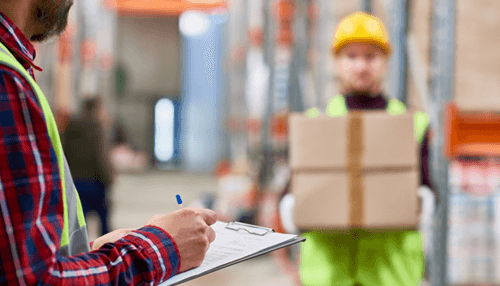Reverse logistics is a far more complex process than regular logistics, creating multiple challenges for businesses, their distributors and contractors. Perhaps the most trying aspect of reverse logistics is that retailers often don’t know what and when products are being returned. Although they may have a returns authorization system in place, they might only become aware of a return when it arrives at the warehouse.
Not all returned products are handled the same way. Businesses must decide what to do with returned products of all types. For example, damaged goods may need to be repaired and sold as refurbished items, while others may not warrant reselling. Companies often use the wrong shipping materials, leading to goods being damaged on transit. Labor-management issues are also tricky, as staff must be assigned specially to look after returns.
Reverse logistics is also crucial from a customer service standpoint. Up to 95% of customers who are happy with the returns process claim they’ll purchase from the same retailer again. Despite its importance, many businesses struggle to implement an effective reverse logistics process. Fortunately, several key actions can help improve a reverse logistics process significantly.
1. Identify Reasons for Returns
Frequent returns are expensive to accommodate. If your business is experiencing a high demand for returns, it’s crucial to identify the reason. There may be some glaring errors or recurring reasons that returns are happening, meaning you can act quickly to improve the process. There may be problems with specific products that can be solved quite easily.
For example, if one of your products is being sent back continually because the assembly instructions are unclear, the directions can be modified.
It’s not enough to just focus on the reasons customers buy products. You must understand the entire customer journey, from the initial point of contact to why they send an item back. This allows you to discover patterns or common problems.
Solving reasons behind product returns should not only lead to a reduction in future returns but make for a much happier customer base and cost savings.
2. Create a Transparent Returns System
One of the major annoyances for customers when it comes to returns is that it is often far more complicated than purchasing. In the age of single-click purchases and same-day delivery, eCommerce shopping is incredibly convenient. Customers often expect the returns process to be just as straightforward.
Your return policy should be clear and easy to understand. Ensure your returns policy is transparent so there is no confusion and so staff members can relay the correct information to your customers.
3. Utilize Technology
Warehousing and supply chain management software can be leveraged to improve the reverse logistics process. Depending on your budget and the size of the organization, investing in new software can be worthwhile.
A reliable inventory management system is essential software for all aspects of the supply chain, including returns. Other useful systems include warehouse management systems (WMS) and transportation management systems (TMS). Tracking technology ensures you know where goods are at all stages of the delivery. This type of software also makes it easier to organize records and documentation needed for generating returns.
Ensure your customer service team uses VoIP phones to maintain consistent contact with customers at every stage of the product life cycle. This ensures you can relay real-time information regarding the status of their goods.
4. Include Returns Labels with Original Packaging
A simple but effective method of making returns much easier for customers is including return shipping labels with the original product packaging. It reduces delays, increases customer satisfaction and allows organizations to take more control over the process.
It’s becoming increasingly popular for businesses to offer free returns using pay-on-use labels. These are scannable labels that are only charged for when they’re scanned. Since they don’t need to be prepaid, they are ideal for including with the original packaging.
If possible, businesses should incorporate free returns within a reasonable timeframe. This increases costs, but the improved service offering can lead to long-term benefits. Design a system that allows for efficient returns and utilize scannable labels to track and monitor the products at all times.
5. Create Priority Restock Items
Businesses need to create and utilize a priority restock list of items. This ensures that important goods are placed back onto warehouse shelves as fast as possible. It’s also imperative that these restock lists are linked to your inventory management system to keep them up to date.
Returns should also be labeled as priority or restock items. Once they can be scanned and re-entered into the system quickly, the returns process can be run much more efficiently when the items get back to the warehouse.
6. Utilize the Right Packaging
On average, manufacturers spend between 9% and 15% of their total revenue on returns. Many items arrive at their destination already damaged. According to Barclaycard, over 25% of refunded items are not fit to be resold. Product packaging has a significant impact on the state that goods arrive in.
Using suitable packaging materials is beneficial for the reverse logistics process in two important ways. First, durable packaging keeps goods intact during transit. Second, if you encourage returns to be sent back in the original packaging, it reduces the likelihood of further damage.
Find a reliable packaging provider that can offer durable and customized packaging for your items. Ensure you use bubble wrap, packaging peanuts, air pillows and other protective accessories for fragile goods.
An ePacket is a practical option for sending packages overseas, particularly between the U.S. and China, because it offers end-to-end tracking, lower shipping rates, a faster delivery time and free returns on undelivered items.
Don’t Overlook the Importance of Reverse Logistics
There’s no doubting the difficulties and complexities associated with reverse logistics. As well as being a challenging process to create a strategy for, it directly influences relationships with customers and business partners.
A complicated and poorly managed reverse logistics process can be harmful in terms of increased costs, more repairs, reputation damage and reduced sales. With a dedicated strategy and suitable software and technology, reverse logistics can be improved, enhancing your business relationships and increasing your bottom line.




